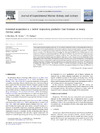Identificador persistente para citar o vincular este elemento:
https://accedacris.ulpgc.es/jspui/handle/10553/6879
| Título: | Potential respiration is a better respiratory predictor than biomass in young Artemia salina | Autores/as: | Martínez, I. Gomez, M. Packard, T. T. |
Clasificación UNESCO: | 251001 Oceanografía biológica | Palabras clave: | Artemia salina ETS activity Biomass Potential respirationa Respiration |
Fecha de publicación: | 2010 | Publicación seriada: | Journal of Experimental Marine Biology and Ecology | Resumen: | These experiments test whether respiration can be predicted better from biomass or from potential respiration, a measurement of the mitochondrial and microsomal respiratory electron transport systems. For nearly a century Kleiber's law or a similar precursor have argued the importance of biomass in predicting respiration. In the last decade, a version of the Metabolic Theory of Ecology has elaborated on Kleiber's Law adding emphasis to the importance of biomass in predicting respiration. We argue that Kleiber's law works because biomass packages mitochondria and microsomal electron transport complexes. On a scale of five orders of magnitude we have shown previously that potential respiration predicts respiration aswell as biomass inmarine zooplankton. Here, using cultures of the branchiopod, Artemia salina and on a scale of less than 2 orders of magnitude,we investigated the power of biomass and potential respiration in predicting respiration.We measured biomass, respiration and potential respiration in Artemia grown in different ways and found that potential respiration (Ф) could predict respiration (R), both in μlO2h−1 (R=0.924Φ+0.062, r2=0.976), but biomass (as mg dry mass) could not (R=27.02DM+8.857, r2=0.128). Furthermore the R/Ф ratio appeared independent of age and differences in the food source. | URI: | https://accedacris.ulpgc.es/handle/10553/6879 | ISSN: | 0022-0981 | DOI: | 10.1016/j.jembe.2010.05.011 | Fuente: | Journal of Experimental Marine Biology and Ecology [ISSN 0022-0981], v. 390, p. 78-83 |
| Colección: | Artículos |
Citas SCOPUSTM
13
actualizado el 08-jun-2025
Citas de WEB OF SCIENCETM
Citations
13
actualizado el 08-jun-2025
Visitas
139
actualizado el 10-ago-2024
Descargas
290
actualizado el 10-ago-2024
Google ScholarTM
Verifica
Altmetric
Comparte
Exporta metadatos
Este elemento está sujeto a una licencia Licencia Creative Commons

